Determination of Symmetrical Figures
Analysis of Eye-Tracking in Students' Answer to Line Symmetry Figures
Author: Cheng-Yu Sung, John J. H. Lin
Graduate Institute of Science Education, National Taiwan Normal University, Taipei, Taiwan
The total number of questions is six, and all questions are presented as follows:
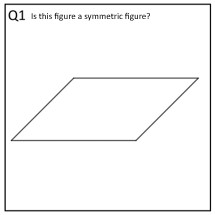
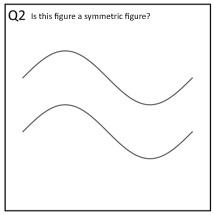
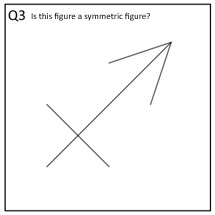
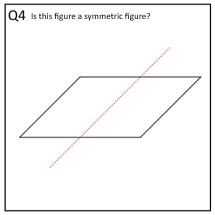

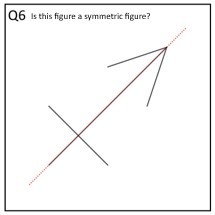
The only difference between Q1 and Q4, Q2 and Q5, and Q3 and Q6 is whether a red confounding (or symmetrical) line exists or not.
The participants are asked to determine whether it is a symmetrical figure and mark 'yes' or 'no' in the answer area.
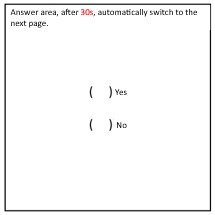
Research goals:
1. Identify the reasons for students' incorrect responses.
2. Examine whether confounding line affect students' determinations of symmetrical figures.
3. Investigate students’ cognitive processes using eye-tracking technology when they observe line-symmetric figures.
Variables for Analysis:
- Response duration/answer
- Total fixation counts in the text area
- The fixation duration on the red area
- The fixation duration on the blue area
- Scanpath pattern
Analyze the conditions of each question.
Q1 and Q4:
 Response duration/Answer: 27 seconds/Correct
Response duration/Answer: 27 seconds/Correct
Total fixation counts in the text area: 1 time
The fixation duration on the center (red area): 5 seconds
The fixation duration on the edges of the image (blue area): 4 seconds
Scanpath pattern: Question → Blue Area → Red Area
 Response duration/Answer: 23 seconds/Incorrect
Response duration/Answer: 23 seconds/Incorrect
Total fixation counts in the text area: 1 time (but almost negligible)
The fixation duration on the center (red area): 6 seconds
The fixation duration on the edges of the image (blue area): 12 seconds
Scanpath pattern: Question → Blue Area 1 (6 seconds) → Blue Area 2 (2 seconds) → Red Area (4.5 seconds) → Blue Area 2 (3 seconds) → Red Area (1.5 seconds) → Blue Area 2 (1 second)
Although the response duration for Q1 was relatively long, much of the time was spent looking at blank areas. We speculate that it might be caused by the student familiarizing himself/herself with the interface during the test. The actual time spent on the problem-solving was approximately 18 seconds (if timing started when the question was presented). Additionally, we found that introducing confounding lines resulted in more incorrect responses, as seen in Q4. In Q4, the student spent a lot of time looking at the red line, suggesting that the confounding line had a significant lure. Moreover, comparing the response durations, 18 seconds for Q1 versus 23 seconds for Q4, it can be inferred that students took more time to think about Q4. This was primarily attributed to the increased time spent observing the edges of the figure.
Worth noting is that students did not look at the bottom of the figure.
 Response duration/Answer: 25 seconds/Incorrect
Response duration/Answer: 25 seconds/Incorrect
Total fixation counts in the text area: 1 time
The fixation duration on the center (red area): 0.5 seconds
The fixation duration on the edges of the image (blue area): 14.5 seconds
Scanpath pattern: Question → Blue Area 1 (8 seconds) → Blue Area 2 (2 seconds) → Red Area (0.5 seconds) → Blue Area 3 (4 seconds) → Blue Area 4 (0.5 seconds)
 Response duration/Answer: 18 seconds/Incorrect
Response duration/Answer: 18 seconds/Incorrect
Total fixation counts in the text area: 1 time (but almost negligible)
The fixation duration on the trough of the red line (red area): 3 seconds
The fixation duration on the edges of the image (blue area): 11 seconds
Scanpath pattern: Question → Blue Area 2 (4 seconds) → Blue Area 1 (2 seconds) → Blue Area 3 (2 seconds) → Blue Area 2 (3 seconds) → Red Area (3 seconds)
Both Q2 and Q5 were answered incorrectly, yet Q2 had a significantly longer response duration, with most of the time spent looking at blank areas. We speculated that for this type of figure, students tend to engage in mental deliberation regarding its line symmetry. As for the situation in Q5, the introduction of the red confounding line shifted the students' attention to the red line (as evidenced by a 3-second fixation on the trough of the red line). Having a reference point expedited the thought process.
It's noteworthy that in Q2, the student looked at all four sections of the blue area (Blue Area 1, 2, 3, and 4), whereas in Q5, only Blue Area 1, 2, and 3 were observed, and Blue Area 4 was neglected.
 Response duration/Answer: 14 seconds/Correct
Response duration/Answer: 14 seconds/Correct
Total fixation counts in the text area: 1 time (but almost negligible)
The fixation duration on the tip (red area): 3 seconds
The fixation duration on the intersection (blue area): 1.5 seconds
Scanpath pattern: Question → Red Area → Blue Area
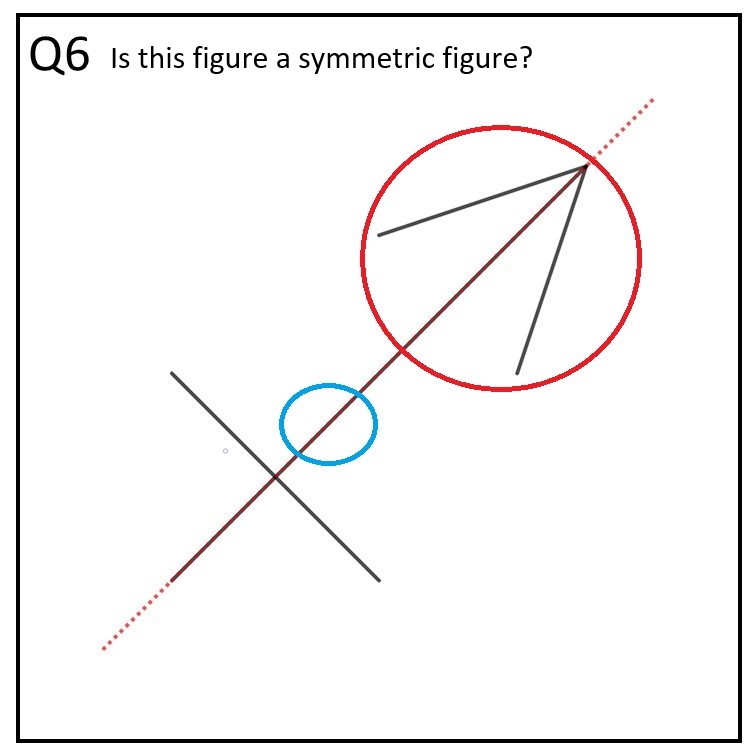 Response duration/Answer: 7 seconds/Correct
Response duration/Answer: 7 seconds/Correct
Total fixation counts in the text area: 1 time (but almost negligible)
The fixation duration on the tip (red area): 1.5 seconds
The fixation duration on the upper part of the intersection (blue area): 0.5 seconds
Scanpath pattern: Question → Red Area → Blue Area
Both of these questions were answered correctly, with Q6 having an exceptionally rapid response time. It can be inferred that drawing the symmetry line would aid students in determining whether it is a symmetrical figure. The commonality between the two is that the fixation duration on the tip (red area) was the longest when students watched the figure. It is worth noting that in Q3, students fixated on the intersection (blue area), while in Q6, they fixated on the upper part of the intersection (blue area), approximately the center of the figure. This is an interesting observation that could be further explored.
In the final analysis of Q1-Q6, it is observed that students spent the longest time reading Q1, followed by Q2, which took about 1-2 seconds. However, for Q3-Q6, students almost glanced at the text area and quickly proceeded to judge the figure. While this may be related to the similarity of the questions in this study, there are still many aspects worth discussing.
Discussion:
1. Regarding the text of the questions, it can be observed that from the third question onwards, there was almost no significant attention given to the text; students merely glanced at it. What would happen if the wording of the questions were slightly altered (e.g., changing "line symmetry" to "point symmetry")? Would there be a sudden increase in the time spent looking at the question? Would the accuracy of responses decrease? Would students not notice the change and continue with the same thought process as in the previous questions?
2. Confunding lines and symmetry axes exhibit considerable allure (as seen in Q1, where the answer was correct, but Q4 was incorrect; Q6 was answered much faster than Q3). For geometry problems, if confounding lines were drawn on the figure, would it affect students? If auxiliary lines were provided, would it assist students? Is the ability to judge line symmetry positively correlated with geometric or spatial abilities?
3. Students seem to struggle to determine whether a figure is line symmetrical (questions rated below 5 in difficulty, yet a 3/6 correct response rate).
4. It is conceivable that the post-test would show an increase in the correct response rate. However, in terms of eye-tracking analysis, whether there will be different findings remains to be explored further.


